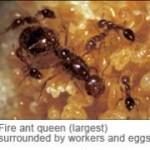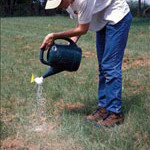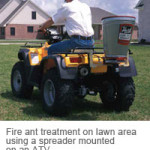Fire Ant Control: The Two-Step Method and Other Approaches
 When it comes to insect pests, fire ants would probably top everyone’s list! Red and black imported fire ants (Solenopsis invicta and Solenopsis richteri) are invasive species and their painful bites can injure or kill livestock, wildlife, domestic animals, and humans. Their large mounds (as many as 300 per acre) are unsightly and often damage mowers and other equipment. Fire ants also infest buildings and can damage electrical equipment by chewing on wire insulation.
When it comes to insect pests, fire ants would probably top everyone’s list! Red and black imported fire ants (Solenopsis invicta and Solenopsis richteri) are invasive species and their painful bites can injure or kill livestock, wildlife, domestic animals, and humans. Their large mounds (as many as 300 per acre) are unsightly and often damage mowers and other equipment. Fire ants also infest buildings and can damage electrical equipment by chewing on wire insulation.
Fire ants cost Americans $6 billion a year, including the cost of insecticides. The Two-Step Method and other approaches described here can lower that cost while reducing environmental damage and improving fire ant control. Knowing your options will allow you to make better choices to protect your family, pets, and property.
Identifying Fire Ants
There are hundreds of ant species in the southern United States, including some native fire ant species, and most of them are considered beneficial insects. Collectively, ants till more earth than earthworms and some prey on other insect pests to help to reduce their numbers.
Fire ants will build their mounds almost anywhere—in the open or next to a building, tree, sidewalk, or electrical box. A fire ant mound does not have a central opening. Fire ants emerge quickly and begin biting and stinging when the mound is disturbed. They will even run up vertical surfaces.
Worker fire ants are dark reddish-brown with shiny black abdomens, and are about 1/16- to about 1/4-inch long. Fire ants are similar in appearance to many other ants, so make sure you have correctly identified the species before attempting to solve your ant problem. If you are uncertain about the species, call your local extension office for assistance in identifying your ants.
Controlling Fire Ants
Most people (about 80 percent according to one survey) try to control fire ants by treating individual mounds. Mound treatments are expensive, up to $2 or more per mound, and require lots of time and labor if you have much land to treat. You can easily use too much insecticide, which may lead to environmental contamination if rain-washes the insecticide into lakes and streams. To be effective, the mound treatment must kill the queen(s). Otherwise, the colony will survive. Some nests may go undetected. Even an area where every mound has been treated can soon be re-infested by fire ant colonies migrating from untreated areas or floating there on floodwater. In addition, deep-dwelling colonies that escaped mound treatment can quickly form mounds after a soaking rain. It is usually more effective and less expensive for homeowners to treat the entire yard with a product designed for broadcast application.
Fire ants cannot be eliminated because it is not possible to treat all infested areas. There may not be one best method for fire ant control, especially in large areas. Your objective should be to find the method or methods that are most cost-effective, environmentally sound, and fit your tolerance level for fire ants. In areas where these ants do not present problems, doing nothing is one option. Another option is to implement an integrated pest management program (IPM). IPM incorporates biological control methods and selective use of insecticides.
Types of Control
Biological control: Government and university researchers have imported and tested natural enemies of fire ants, such as parasitic decapitating flies from South America. These natural enemies have been successful in areas where they have been released but they are not available to the general public. However, ongoing release programs in all infested states are making decapitating flies more prevalent in the environment. Biological control agents available on the retail market, such as parasitic nematodes, do not sustain themselves or spread on their own once they are released.
Home remedies: Many home remedies have been devised to control fire ants. Drenching a mound with two to three gallons of almost boiling water eliminates ant colonies about 60 percent of the time, but it will also kill plants the water contacts. This method is labor intensive and the hot water must be handled carefully. Some home remedies, such as applying instant grits, molasses, aspartame or club soda to ant mounds, do not work. Pouring chlorine, ammonia, gasoline or diesel fuel on mounds can contaminate the soil and groundwater, is dangerous, and is strongly discouraged.
Organic products: A few products are certified as organic. These include ingredients such as d-limonene, an extract from citrus oil, or spinosad, a chemical complex produced by a soil microbe.
Chemical control: The use of insecticides for fire ant control is regulated by the Environmental Protection Agency. Approved products must be used according to label directions. Read the label carefully! An approved product is one that has directions for fire ant control on the label. Be sure it is appropriate for where you intend to use it, particularly if you will be treating a vegetable garden or other food production site. Products for use in electrical utility boxes and indoors may not be available at retail stores and some products are for use only by professional pest control operators.
Control Products
Most active ingredients are marketed under more than one brand or trade name. This article refers to the generic names of the active ingredients in insecticides, which you should see on the product labels. Some sample trade names are given as well.
Products are formulated as dusts, granules, liquid drenches or baits. They are applied either to individual ant mounds or across the surface of the ground (broadcast). The various active ingredients affect ants in different ways.
Most active ingredients are contact insecticides that affect the nervous system of ants. Contact insecticides include acephate (Orthene®), carbaryl (Sevin®), fipronil (Top Choice® or Taurus™ G) broadcast granules, which are restricted use professional products, pyrethrins, pyrethroids (bifenthrin, beta-cyfluthin, cyfluthrin, cypermethrin, deltamethrin, gamma-cyhalothrin, lambda-cyhalothrin, permethrin, esfenvalerate, tefluthrin, tralomethrin, or zeta-cypermethrin), and liquid spinosad formulations. These ingredients vary in how quickly they kill ants and how long they remain in the environment. Natural pyrethrins and synthetic pyrethroid ingredients kill ants in minutes. Acephate and carbaryl take about one day, while granular fipronil may take four to six weeks to eliminate colonies. Hot water, pyrethrins, and d-limonene treatments have little or no lasting effect. Carbaryl, spinosad, and acephate break down in a matter of days to weeks. Pyrethroids can remain in the environment for weeks to months, while fipronil can persist as long as a year.
Baits contain active ingredients dissolved in a substance ants eat or drink. Some bait ingredients affect the nervous system. These include abamectin (Ascend®, Award® II, Clinch®, Optigard®), indoxacarb (Advion®), metaflumizone (Altrevin™, Siesta™), spinosad (Fertilome Come and Get It! or Payback), and fipronil (MaxForce FC). Some affect the digestive system (boric acid) or metabolism (hydramethylnon or Amdro®, Probait®). Other bait ingredients interfere with reproduction or growth. These include methoprene (Extinguish®), and pyriproxyfen (Distance® or Esteem®). A relatively new type of bait combines two active ingredients, hydramethylnon and methoprene (Amdro® FireStrike or Extinguish® Plus).
To be effective, baits must be fresh and applied when ants are actively foraging. To determine if the time is right for treatment, place a small amount of bait in the area to be treated and see if foraging ants remove it within an hour. Because ants collect, bait and return it to the colony, very little insecticide is needed. Baits are ruined by water, so do not water baits after application, or apply them when rain is expected.
Control Approaches – The Two-Step Method
Step 1. Broadcast fire ant bait once or twice a year to reduce fire ant colonies by 80 to 90 percent.
Step 2. Treat nuisance mounds or colonies that move into the bait-treated areas. Step 2 may not be needed.
Baiting is the most cost-effective and environmentally sound approach to treating medium to large landscape areas. The bait you apply determines how quickly ants will be controlled and how long the effect will last. Faster acting bait products include indoxacarb (works in 3-7 days), metaflumizone (works in 7-10 days), hydramethylnon (works in 7-14 days for mound treatments and in 2-3 weeks when broadcast), and spinosad (works quickly on foraging ants but may take several weeks for reduction in mound activity). These baits may need to be reapplied more often than slower acting and longer lasting products such as abamectin, methoprene or pyriproxyfen, which work in 1-2 months when applied in spring and six months when applied in fall. Products that combine fast- and slow-acting ingredients, such as hydramethylnon plus methoprene (Extinguish® Plus or Amdro® Firestrike), may control ants better because they act quickly and last longer. Certified organic products that contain spinosad such as Fertilome® Come and Get It! or Payback® Fire Ant Bait can be used for broadcast bait and mound treatments. Use products such as Amdro® Pro, Esteem®, Extinguish®, or Extinguish® Plus for livestock pastures and hay fields.
Always read and follow the application instructions on the label of the product you are using. Use a hand-held spreader/seeder or a standard push spreader to correctly broadcast bait products. Use the hand held spreader/seeder for baits that are applied at very low rates such as one to five pounds of product per acre. Use the push-type lawn for baits that are applied at higher volumes per acre (two to five pounds per 5000 square feet). Use a vehicle-mounted spreader such as the Herd® GT-77 to cover large areas. For home lawns, calculate the area to be treated and use the smallest spreader setting that allows bait to flow. Apply the bait in swaths, crisscrossing swaths if needed, until the specified amount is applied. For larger areas, see How to Calibrate a Fire Ant Bait Spreader. The agitators in some spreaders may cause bait to cake up so that it does not flow properly.
Individual Mound Treatments
Although treating ant mounds individually is more labor-intensive and may use more insecticide than other methods,  it is a suitable approach for small areas with few fire ant mounds (fewer than 20 per acre) or where you want to preserve native ants. Bait products (hydramethylnon, indoxacarb, spinosad) can be used to treat individual ant mounds and are ideal for treating inaccessible colonies like those nesting under sidewalks, in plant beds, and at the bases of tree trunks.
it is a suitable approach for small areas with few fire ant mounds (fewer than 20 per acre) or where you want to preserve native ants. Bait products (hydramethylnon, indoxacarb, spinosad) can be used to treat individual ant mounds and are ideal for treating inaccessible colonies like those nesting under sidewalks, in plant beds, and at the bases of tree trunks.
Some mound treatment products are available as liquid drenches, injectable aerosols, dusts, or granules that are watered in to the mound. Ants are killed only if the insecticide contacts them, so proper application is essential. These treatments are most effective when ants are nesting close to the mound surface (as they do when the temperature is mild). Colonies should not be disturbed during treatment. If you use a watering can to apply insecticide, do not use the can later for other purposes.
Long-residual Broadcast Contact Insecticide Treatments
With this approach, a contact insecticide is applied to the lawn and landscape surface. This is more expensive than other control methods but it may be more effective in smaller areas because ants that move into treated areas will be eliminated as long as the chemical is active. Granular products are best applied with a push-type fertilizer spreader and must be watered in after treatment. Granular fipronil products (TopChoice® or Taurus™ G) are slower acting but longer lasting and only one treatment is permitted per year. Faster-acting contact insecticides, such as the pyrethroids (listed above), eliminate ants on the surface for months but may not eliminate colonies nesting deeper in the soil.
Make a Management Plan
Chemical control lasts only as long as the effects of the insecticide used, or until new ant colonies move in from untreated areas. You can expect an ant infestation to return to its original level eventually. Thus, keeping fire ants in check requires a commitment of time and money. To reduce the cost and make control easier, consider making a map of your property. Divide the property into treatment areas and designate the most appropriate treatment approach for each area. Make and maintain a schedule for first treatment and any necessary re-treatments.
For example, you might use a long-residual broadcast contact insecticide at regular intervals in high-value or high-traffic areas (near buildings or in play or recreation areas) where maximum control is needed. In other areas, where 80 to 90 percent control of ants is acceptable, you might use the Two-Step Method. Because control lasts longer when large areas are treated, consider participating in a community- or neighborhood-wide treatment program. These have been shown to improve control and reduce cost. If everyone participates by making coordinated treatments, ant colonies will not be able to migrate from property to property.
For Texas Schools see this fact sheet for additional information to establish a fire ant management program Fire Ants and the Texas IPM in Schools Program
Authors
Bastiaan M. Drees, Retired, Professor and Extension Entomologist; Kimberly Schofield, Elizabeth “Wizzie” Brown, Paul Nester, and Molly Keck, Extension Program Specialists; Texas A&M AgriLife Extension. Kathy Flanders, Alabama Cooperative Extension System.
EPA Awards More than $500,000 to Schools to Help Reduce Children’s Exposure to Pesticides
Integrated pest management practices are shown to reduce pesticide use By Cathy Milbourn
On March 12, 2014, the U.S. Environmental Protection Agency (EPA) announced three grants to facilitate integrated pest management practices in schools. This funding will help reduce student’s exposure to pests and pesticides in the nation’s schools, while saving money, energy and pesticide treatment costs.
“Children are among the most vulnerable members of our society, and it’s EPA’s job to protect them from harmful chemicals,” said James Jones, Assistant Administrator for the Office of Chemical Safety and Pollution Prevention. “We aim to help schools implement sustainable pest management practices to create a healthier environment for our children and teachers.”
 Integrated Pest Management (IPM) reduces pesticide use, helps to eliminate pests and saves schools money. For example, 18 schools in Monroe County, Indiana have reduced both pesticide use and pest control costs by 90 percent using IPM practices. This approach has the potential to reach all 15,000 school districts and improve the health and well-being of the 49 million children attending public and tribal schools in the United States.
Integrated Pest Management (IPM) reduces pesticide use, helps to eliminate pests and saves schools money. For example, 18 schools in Monroe County, Indiana have reduced both pesticide use and pest control costs by 90 percent using IPM practices. This approach has the potential to reach all 15,000 school districts and improve the health and well-being of the 49 million children attending public and tribal schools in the United States.
IPM measures help prevent pests from becoming a threat by taking action to address the underlying causes that enable pests to thrive in schools. These actions, such as repairing water leaks, adding weather stripping to windows, and installing door sweeps, reduce pesticide use and treatment costs while reducing water and energy costs. The IPM common-sense approach is a stark contrast to conventional pest management in which an exterminator uses pesticides school-wide on a regular schedule, potentially exposing school children, teachers and staff to pesticides, with little emphasis on removing the underlying conditions that make it inviting to pests.
The three grants will be awarded to:
The Texas A&M AgriLife Extension to develop a central, internet-based hub for materials and phone apps that will give school districts the information and tools they need to adopt an IPM program. While the project aims to reach 1 percent of schools (552,350 students) within three years, it has the potential to reach all of the 15,000 school districts nation-wide and the 49 million children attending US public schools.
The University of Arizona to develop and carry out a pilot training and certification program for school staff (custodians, kitchen staff, and school administrators) in eight states and four tribes, working with five other universities and stakeholders. Once finalized, the materials will be made available to schools nation-wide through partners.
The Michigan State University to help 5 percent of Michigan and Indiana schools adopt IPM through hands-on education, training, and coalition building, including web-based trainings and a website. About 135,000 children may be protected.
For additional information on the three funded grants and IPM in schools, visit: www.epa.gov/pestwise/ipminschools/grants.
Read our blog: Is Your Child’s School Stuck on a Pest Control Treadmill?
Oregon Schools Use Gardens to Teach Academic, Life Lessons
Schools in Oregon have access to resources from the state department of education about how to use school gardens in student learning. The Oregon Farm to School and School Garden Program provides suggested curriculum and resources to schools to create gardens, along with lessons in math, science, healthy eating and environmental care. Read more at http://www.oregonlive.com/hg/index.ssf/2014/03/thumbs_up_for_green-thumb_scho.html.
Texas Students, Schools to Benefit from New Law on School Breakfast
Breakfast for all is a win-win for students and schools. Studies show that students who are well fed participate more in class and earn higher grades, and because schools are reimbursed based on the number of meals served, higher student participation means more money for the program. This week, the Center for Public Policy Priorities released “Making Breakfast Big in Texas,” a resource for anyone interested in ways that Texas schools can serve breakfast to all their students while maximizing revenue. To read the press release, go to http://org2.salsalabs.com/o/6212/t/0/blastContent.jsp?email_blast_KEY=1283870. To access “Making Breakfast Big”, go to http://forabettertexas.org/images/FN_2014_02_BreakfastForAll_web.pdf.
Maryland Officials Call for All-You-Can Eat Fruits, Veggies in Schools
Members of the Montgomery County Council in Maryland are proposing local schools make unlimited quantities of fruits and vegetables available to students. District officials, however, say such a plan is not financially feasible. Other council recommendations include preparing more made-from-scratch meals, limiting sugar and giving students greater access to water. Read more at http://www.gazette.net/article/20140312/NEWS/140319790/1080/county-council-members-want-montgomery-students-to-get-unlimited&template=gazette.
Massachusetts School Makes Exercise, Breakfast Part of Morning Routine
Students at an elementary school in Massachusetts get an hour of exercise and nutrition lessons every morning before eating breakfast. The school launched the before-school program for students as part of the YMCA’s Healthy Future Initiative. “We’ve seen improved academic success for the kids who are able to move in the beginning of the day,” said Kimberly Cohen, senior director of health and wellness at the YMCA’s Franklin branch. Read the news story at http://www.milforddailynews.com/article/20140312/NEWS/140319002/1994/NEWS.


 .
.